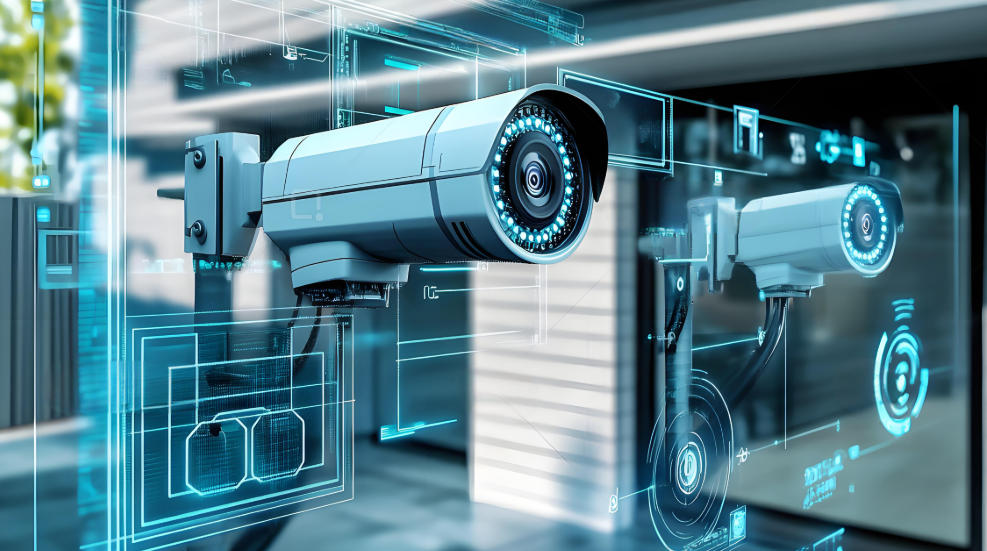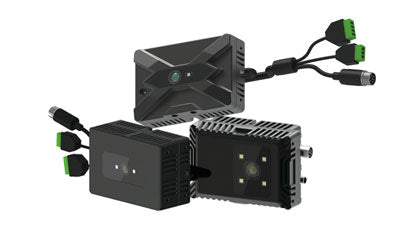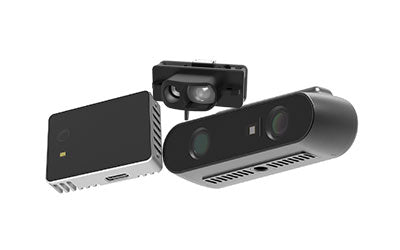TOF Technology for Blind-Spot-Free Industrial Safety Monitoring

How Can TOF Technology Deliver All-Round Safety Monitoring in High-Risk Factory Areas?
In industrial production environments, safety management is always a top priority. However, as production scales expand and operational environments become more complex, traditional video surveillance methods are showing limitations and failing to meet the safety demands of high-risk workplaces. Emerging TOF (Time-of-Flight) (https://en.wikipedia.org) monitoring technology, with its 3D sensing and precise positioning capabilities, offers a new solution for industrial safety. It enables hazardous area detection and personnel protection with full coverage and no blind spots.
What Is a TOF (Time-of-Flight) Camera?
A TOF camera (Time of Flight Camera) is a 3D imaging device based on the time-of-flight principle. It emits modulated light pulses or continuous waves (usually infrared) toward a target object, receives the reflected light signal, and measures the time (or phase shift) it takes to travel. Using the speed of light and flight time, the exact distance between the object and the camera can be calculated, generating high-precision depth images and 3D point cloud data.
Key Features of TOF Cameras:
-
High real-time performance – Quickly captures depth information, ideal for dynamic target detection.
-
High accuracy – Time differences in the microsecond to nanosecond range enable millimeter-to-centimeter precision.
-
Strong adaptability – Works in low light or total darkness, independent of ambient light.
-
Wide applications – Used in industrial automation, robotics navigation, gesture recognition, smart security, logistics and warehousing, and autonomous driving.
In short, a TOF camera is a device that can 'see distance.' It not only captures 2D images of objects but also provides 3D depth information for every pixel point.

1. Pain Points in Industrial Safety Management
Traditional industrial safety systems mainly rely on 2D video surveillance. As production expands and environments grow more complex, these systems reveal significant shortcomings, falling short of modern safety standards.
-
Blind spot issues: Conventional cameras have a limited field of view (FOV). Their coverage is affected by installation position, angle, and obstacles, often leaving blind spots behind large equipment, corners, or multi-layered structures. Worker operations in these areas may go unmonitored, creating hidden risks.
-
Lack of real-time response: Traditional systems are more 'after-the-fact' tools for evidence collection. When danger occurs, surveillance often provides only playback, without real-time risk detection or alerts. In high-risk environments requiring second-level responses, such delays can worsen accidents.
-
Poor environmental adaptability: Industrial sites often feature low lighting, glare, smoke, or dust. In such conditions, 2D cameras lose clarity or even fail entirely. In high-temperature furnaces, chemical plants, or dusty workshops, their effectiveness is especially limited.
-
Limited data value: 2D images lack depth information and cannot provide robot distance sensing or precise 3D hazard localization. This hinders integration with AGVs, robotic arms, and other environmental sensors, preventing automated intervention and proactive protection.
These challenges reduce the efficiency of safety management and increase accident risks. Enterprises need smarter, 3D-enabled sensing methods to overcome these limitations and achieve blind-spot-free monitoring with proactive safety protection.
2. Advantages of TOF Depth Monitoring Technology
TOF monitoring uses the Time-of-Flight principle to emit light pulses and measure their return time, rapidly generating precise 3D depth data. Compared to traditional 2D cameras, TOF offers unique advantages for industrial safety:
-
Comprehensive 3D sensing – Captures the full 3D spatial layout of people, machines, and objects in real time. Unlike flat 2D images, TOF delivers environmental sensing, identifying position, size, posture, and movement trajectories—crucial for complex workshops, warehouses, and hazardous zones.
-
Accurate positioning – Even in fast-moving environments, such as assembly lines or worker movement, TOF provides real-time tracking with ultra-low latency. It precisely measures robot distances and worker positions, preventing dangerous contact with robotic arms or AGVs in confined spaces.
-
Effective in dark and low-light environments – TOF uses active illumination, enabling reliable monitoring in night shifts, tunnels, or mines where traditional cameras fail.
-
Resistant to harsh conditions – Maintains stable performance in environments with smoke, dust, oil mist, or glare, making it highly suitable for steelmaking, chemical plants, and high-voltage power supply sites.
-
Seamless integration with intelligent systems – TOF’s 3D data can link with environmental sensors, AI analytics, and IoT platforms, enabling automated alerts, adaptive protection, and intelligent scheduling. Systems can dynamically adjust coverage (field of regard) and trigger safety measures based on risk levels.
These features make TOF monitoring an ideal solution for eliminating blind spots, improving hazard detection, and enhancing worker safety—shifting industrial safety from 'passive recording' to 'active prevention.'

3. Application Scenarios and Case Studies
With the rise of industrial automation, TOF technology is gaining traction in safety management thanks to its precision, speed, and all-weather capabilities.
-
Hazard zone protection
In high-temperature furnaces, chemical storage, and around heavy machinery, TOF systems provide real-time 3D sensing to locate workers and detect intrusions into danger zones. They can trigger alarms or emergency shutdowns. For instance, in a steel plant, TOF monitoring near furnaces reduced burn risks by issuing early warnings when workers approached too closely. -
Equipment operation monitoring
On automated production lines, TOF tracks robotic arms and conveyors, analyzing their motion paths and proximity to workers. If a person enters a hazardous area, the system can adjust equipment or sound alarms. In electronics manufacturing, TOF integrated with SMT lines allowed robots to avoid collisions with operators, enhancing both safety and productivity. -
High-risk area alarms
In mines, tunnels, and petrochemical plants, TOF combined with personnel tracking delivers real-time location and risk evaluation. If anomalies occur, such as workers lingering or entering restricted zones, the system issues remote alarms and sends 3D imagery for rapid response. In one coal mine, TOF monitoring enabled fast localization of trapped workers during a collapse, improving rescue effectiveness. -
Success stories
Large manufacturers have successfully deployed TOF monitoring, reducing accident rates by over 30% and increasing hazard handling efficiency by around 50%. For example, an auto parts factory installed TOF cameras around robotic arms and assembly lines. Incidents dropped sharply, while managers gained real-time remote monitoring and analytics for smarter safety oversight.
4. Technology Integration and Implementation Plan
To fully leverage the potential of TOF (Time-of-Flight) technology in industrial safety, relying solely on a single sensor is far from sufficient. Deep integration with existing enterprise systems enables comprehensive, multi-layered safety management, enhancing intelligence and response efficiency.
-
Integration with AI Analysis Platforms
High-precision 3D depth data collected by TOF monitoring systems can be transmitted in real time to AI analysis platforms. Through machine learning and computer vision algorithms, the system can automatically identify hazardous behaviors such as unauthorized intrusions, falls, or approaching high-speed machinery. Once an anomaly is detected, AI models can immediately trigger alerts, record behavioral trajectories, and generate reports for safety management decisions. For example, in a heavy machinery workshop, AI combined with TOF data can provide real-time safety monitoring of operators, preventing accidents caused by human error and forming a closed-loop management cycle of 'active protection—alert response—post-event analysis.' -
Fusion with IoT Sensors
TOF technology can be integrated with IoT devices such as temperature sensors, gas detectors, and smoke alarms to achieve multidimensional safety monitoring. For instance, in chemical plants or high-temperature furnace areas, TOF can track personnel location and movements in real time, while temperature sensors monitor equipment heat and gas sensors detect hazardous concentrations. If personnel approach high-temperature zones or gas levels exceed safety thresholds, the system can instantly activate alarms and emergency equipment. This multi-sensor collaborative approach builds a holistic safety protection network covering 'personnel—equipment—environment,' significantly enhancing risk control. -
Compatibility with Existing Safety Systems
To minimize deployment costs and operational complexity, TOF devices are designed with high compatibility. They can seamlessly integrate with existing video surveillance, access control, alarm, and industrial control systems, enabling data sharing and coordinated management. For example, when TOF detects personnel entering a restricted area, the access system can automatically lock relevant passageways, surveillance displays can highlight the alert zone, and the management center can receive real-time notifications. With such integration, enterprises can achieve smart safety management without extensive system overhauls. -
Implementation Plan and Deployment Recommendations
-
Risk Assessment: Evaluate workshops and hazardous zones to determine TOF coverage points and monitoring priorities.
-
System Planning: Plan TOF sensor placement according to facility layout and equipment operation paths, ensuring full coverage of key areas.
-
Data Integration: Connect TOF data streams with AI platforms, IoT sensors, and safety systems to ensure smooth information flow.
-
Intelligent Strategy Configuration: Define warning thresholds and linkage strategies for different scenarios to achieve automated safety responses.
-
Trial Operation & Optimization: Conduct trial runs after deployment, analyze collected data, and refine system accuracy and response speed.
-
Through this integrated approach, enterprises can achieve real-time monitoring of hazardous work zones while also enabling accident prevention, intelligent alerts, and data-driven safety management, thereby building a comprehensive industrial safety ecosystem.

5. Future Trends
With the rapid development of Artificial Intelligence (AI), Big Data, and the Industrial Internet of Things (IIoT), TOF monitoring technology will usher in new transformations in the field of industrial safety. Beyond precise real-time monitoring, it will play a core role in intelligent decision-making, risk prediction, and end-to-end safety management. Key trends include:
-
Predictive Safety Management
Traditional safety management relies heavily on manual inspections and post-incident handling, leading to delays and inefficiencies. In the future, TOF systems will integrate deeply with enterprise historical data, production logs, and environmental records. Using AI modeling, they can predict potential risks in advance. For example, by analyzing operator movement patterns and machine operation cycles, the system can identify high-risk behaviors or danger zones ahead of time, automatically suggesting protective measures or scheduling adjustments—shifting safety management from 'reactive' to 'proactive.' -
Intelligent Warning Systems
With deep learning and behavior recognition, TOF systems will not only detect existing dangers but also predict future risks. By analyzing real-time 3D data of personnel movements, equipment trajectories, and environmental conditions, the system can trigger multi-layer alerts (audible, visual, automated mechanical responses, and central notifications). For example, in furnace areas or chemical storage sites, the system can anticipate personnel approaching hazardous areas and pre-activate protective mechanisms, drastically reducing the likelihood of sudden accidents. -
Data-Driven Safety Optimization
Real-time 3D data generated by TOF monitoring will become a valuable resource for enterprises, supporting process optimization and higher safety standards. Continuous data analysis can reveal risky operator habits, identify danger-prone zones, optimize equipment layouts, and improve workflows. For instance, long-term analysis could help refine robotic arm trajectories, adjust workstation spacing, or enhance safety training programs, thereby boosting both productivity and safety. -
Comprehensive Intelligent Safety Ecosystem
Future TOF technology will integrate with AI, IoT, edge computing, and cloud platforms to build a holistic safety ecosystem spanning 'personnel—equipment—environment—management center.' Enterprises will achieve unmanned hazardous area monitoring, remote command, and accident traceability. As costs decline and maturity increases, TOF monitoring will become a standard feature in industrial safety, advancing toward zero-accident production through intelligent and automated protection.
In the discussion of industrial safety and smart logistics, TOF (Time-of-Flight) monitoring technology is closely related to other technical concepts and application scenarios. For instance, robot distance and distance robot measurement are crucial to ensuring safe robotic operations in complex environments. By combining environmental sensors with environmental sensing, enterprises can dynamically monitor factors such as temperature, humidity, and gas concentration.
In imaging and monitoring system design, concepts like field of regard and define field of view directly affect monitoring coverage and effectiveness. From the power supply perspective, high voltage power supplies (HV supply) are often linked with monitoring and industrial equipment to ensure stable operation.
Regarding TOF itself, two primary implementations exist: dTOF (direct TOF) for long-range, high-accuracy measurements, and iTOF (indirect TOF/ itoff) for short-range, high-speed applications. Finally, distinguishing between define accuracy vs precision is critical for improving the scientific reliability of safety management strategies.
Conclusion
Faced with increasingly complex industrial environments, traditional monitoring methods are no longer sufficient to meet stringent safety demands. TOF monitoring technology delivers a revolutionary upgrade to industrial safety through 3D perception, precise positioning, and full coverage. It eliminates blind spots while enabling hazard detection, personnel protection, and intelligent alerts. As the technology continues to evolve, TOF will play an even more pivotal role in future safety systems, empowering enterprises to build a seamless, intelligent safety defense network for robust protection and reliable operations.
Synexens Industrial Outdoor 4m TOF Sensor Depth 3D Camera Rangefinder_CS40
Our professional technical team specializing in 3D camera ranging is ready to assist you at any time. Whether you encounter any issues with your TOF camera after purchase or need clarification on TOF technology, feel free to contact us anytime. We are committed to providing high-quality technical after-sales service and user experience, ensuring your peace of mind in both shopping and using our products
-
Publié dans
CS40



